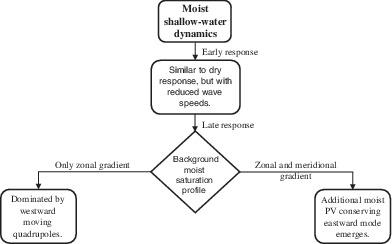当前位置:
X-MOL 学术
›
Q. J. R. Meteorol. Soc.
›
论文详情
Our official English website, www.x-mol.net, welcomes your
feedback! (Note: you will need to create a separate account there.)
Moist shallow‐water response to tropical forcing: Initial‐value problems
Quarterly Journal of the Royal Meteorological Society ( IF 3.0 ) Pub Date : 2020-07-11 , DOI: 10.1002/qj.3867 D.L. Suhas 1 , Jai Sukhatme 1, 2
Quarterly Journal of the Royal Meteorological Society ( IF 3.0 ) Pub Date : 2020-07-11 , DOI: 10.1002/qj.3867 D.L. Suhas 1 , Jai Sukhatme 1, 2
Affiliation

|
The response of a spherical moist shallow‐water system to tropical imbalances in the presence of inhomogeneous saturation fields is examined. While the initial moist response is similar to the dry reference run, albeit with a reduced equivalent depth, the long‐time solution depends quite strikingly on the nature of the saturation field. For a saturation field that depends only on latitude, specifically one with a peak at the Equator and which falls off meridionally in both hemispheres, height imbalances adjust to large‐scale, low‐frequency westward‐propagating modes. When the background saturation environment is also allowed to vary with longitude, in addition to a westward quadrupole, there is a distinct eastward‐propagating response at long times. The nature of this eastward‐propagating mode is well described by moist potential vorticity conservation and it consists of wave packets that arc out to the midlatitudes and return to the Tropics, and are predominantly rotational in character. In all the moist cases, initially formed Kelvin waves decay, and this appears to be tied to the mostly off‐equatorial organization of moisture anomalies by rotational modes. Many of these basic features carry over to the response in the presence of realistic saturation fields derived from reanalysis‐based precipitable water. Considering an imbalance in the equatorial Indian Ocean in the boreal summer, the long‐time eastward response is restricted to the Northern Hemisphere and takes the form of a wave train that passes over the Indian landmass into the Subtropics, reaching across the Pacific to North America. In the boreal winter, the eastward mode consists of a subtropically confined rotational quadrupole along with the midlatitudinal disturbances. Thus, in addition to circumnavigating westward Rossby waves, slow eastward‐propagating modes appear to be a robust feature of the shallow‐water system with interactive moisture in the presence of saturation fields that vary with latitude and longitude.
中文翻译:

浅水对热带强迫的响应:初值问题
研究了非均匀饱和场存在下球形湿浅水系统对热带失衡的响应。尽管初始湿响应类似于干参考运行,尽管等效深度减小了,但长期解决方案非常明显地取决于饱和场的性质。对于仅依赖于纬度的饱和场,特别是在赤道处有一个峰并且在两个半球都在子午线上下降的饱和场,高度不平衡会适应大规模的低频向西传播模式。当还允许背景饱和度环境随经度变化时,除了向西四极杆外,长时间还会有明显的向东传播的响应。湿势涡度守恒很好地描述了这种向东传播模式的性质,它由向中纬度弯曲并返回热带的波包组成,主要是旋转的。在所有潮湿的情况下,最初形成的开尔文波均会衰减,这似乎与旋转模式导致的赤道外组织的湿度异常有关。在基于基于再分析的可沉淀水得出的实际饱和场的情况下,许多这些基本特征都会延续到响应中。考虑到北半球夏季赤道印度洋的失衡,长期向东的响应仅限于北半球,并采取了一种波列火车的形式,该波列穿过印度大陆进入亚热带。跨太平洋到达北美。在北方冬季,向东模式包括亚热带局限的旋转四极子以及中纬度扰动。因此,除了沿西向Rossby波环行外,在饱和度随纬度和经度变化的情况下,缓慢的向东传播模式似乎是具有交互水分的浅水系统的强大特征。
更新日期:2020-07-11
中文翻译:

浅水对热带强迫的响应:初值问题
研究了非均匀饱和场存在下球形湿浅水系统对热带失衡的响应。尽管初始湿响应类似于干参考运行,尽管等效深度减小了,但长期解决方案非常明显地取决于饱和场的性质。对于仅依赖于纬度的饱和场,特别是在赤道处有一个峰并且在两个半球都在子午线上下降的饱和场,高度不平衡会适应大规模的低频向西传播模式。当还允许背景饱和度环境随经度变化时,除了向西四极杆外,长时间还会有明显的向东传播的响应。湿势涡度守恒很好地描述了这种向东传播模式的性质,它由向中纬度弯曲并返回热带的波包组成,主要是旋转的。在所有潮湿的情况下,最初形成的开尔文波均会衰减,这似乎与旋转模式导致的赤道外组织的湿度异常有关。在基于基于再分析的可沉淀水得出的实际饱和场的情况下,许多这些基本特征都会延续到响应中。考虑到北半球夏季赤道印度洋的失衡,长期向东的响应仅限于北半球,并采取了一种波列火车的形式,该波列穿过印度大陆进入亚热带。跨太平洋到达北美。在北方冬季,向东模式包括亚热带局限的旋转四极子以及中纬度扰动。因此,除了沿西向Rossby波环行外,在饱和度随纬度和经度变化的情况下,缓慢的向东传播模式似乎是具有交互水分的浅水系统的强大特征。











































 京公网安备 11010802027423号
京公网安备 11010802027423号